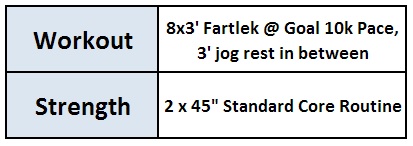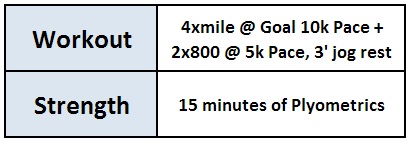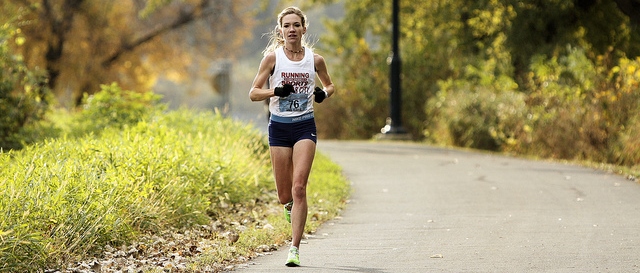Do you know your training age? Most runners don’t – but once you do, planning your racing and training becomes a lot easier.
Training age is a critical part of planning a runner’s overall training program. It’s why I include it in my Runner Questionnaire for those who get a custom training plan. Without it, I wouldn’t be able to customize workouts as well.
So, what exactly is training age?
It’s actually pretty simple: training age is the cumulative amount of time you’ve spent training for a particular sport. It refers to a cumulative workload (and skill level) built over years and years of consistent running.
It’s also important to remember that your lifestyle and general training background impacts your training age and what you’re able to do physically.
A woman who grew up on a farm doing manual labor – and then played eight years of soccer – is much more advanced than someone with no background in sports or manual labor. While her training age as a runner might be zero, her background has a huge impact on the type of workouts and races she’s able to do.
Let’s start with how training age affects your workouts.
Training Age and Workouts
The types of workouts that you can safely do throughout a training cycle are influenced by your training age.
Alright, let’s step back for a minute. Running workouts can range from general to specific. And within those same workouts, there can be activities that are simple or complex.
In this context, general means workouts that do not directly resemble the race you’re training to complete. Simple training sessions have low technical demands and are relatively safe.
Specific workouts resemble your goal race. Complex activities have a higher technical component to them and may present more risks.
Runners with a low training age should be doing more general and simple workouts.
As your training age increases, you’re ready to complete more specific workouts that are complex in nature.
Let’s look at a few examples.

This workout is for a beginner runner training for a 10k with a low training age. The complexity is low and it’s not as specific to the race itself. While the pace is specific to the goal race, the volume of hard running is not.
The strength workout is also a very safe body-weight core routine called the Standard Core Routine.
Here’s an example of a more advanced workout for a runner with a high training age:

This workout is also for a runner training for a 10k race. But it includes more complex and risky activities (plyometrics) and the demands of the workout are much more specific to the race itself.
Those of you with a coaching background will understand this stuff – General to Specific and Simple to Complex concepts are Training Theory 101 ideas. They hold true no matter what sport you’re preparing for (and it’s why CrossFit is not training, but simply exercise).
Training Age and Races
Many beginners are amazed by runners who run their first marathon and get a Boston Qualifying time easily. My debut marathon was 2:44 and many wondered how the hell I did this during my first 26.2!
Well, the best answer is that when I ran my first marathon, my training age was just over 10 years. I had spent ten years training consistently for races 8km long or shorter.
After eight years of gradually building my mileage, running harder and faster workouts according to sound progression, and never racing longer than 5 miles, I raced a 10k. Three months later I raced 10 miles and finally a half marathon a month later.
It took me nearly nine years to race a half marathon. And over ten years to race a marathon.
This example illustrates the fundamental importance of training age (and consistency). Too often a new runner wants to run a marathon during their first year of training. Predictably, they’re surprised when they get hurt during the aggressive mileage build-up or run a finish time that’s underwhelming for them.
26.2 miles is a really long way and completing it – and especially racing it – takes substantial preparation over many years.
And as you develop as a runner, you can start using more advanced pace strategies depending on the race distance. Many beginners are best served with a more conservative approach, while experienced runners can take more risks.
Does this mean you shouldn’t run a marathon during your first year or two of running? No, of course not!
If you love the atmosphere of a big race and can safely train for one, then go for it! But from a training perspective, your overall development of a runner (if that’s something you care about), is better served focusing on training that’s more appropriate for your training age.
Training Age and Strength Workouts
How long you’ve been consistently training even influences the type of strength workouts you should be doing.
A quick example is that I coach some runners who do some very advanced strength exercises like dead lifts. I coach some other runners who I’d never tell to do dead lifts. The former have been training for the better part of a decade. The latter are just getting into the sport and are beginners when it comes to strength workouts.
Olympic lifts are more dangerous, require near perfect form, and are much more technical. So they’re reserved for runners with a high training age who have developed the ability to do them well. The same is true for plyometrics.
Training age is one of the reasons why the strength routines in Injury Prevention for Runners have up to three different levels. Depending on your ability and how long you’ve been training, you should start at a different level than another runner.
Putting it All Together
I love this topic because of its influence on training theory and the planning of sound running programs. There are other aspects of maximizing your performance and preventing injury, but these are three very high-level ways to do it.
Let’s combine everything – workouts, races, and strength work – and see how it all fits together.
Beginner runners with a training age under three consistent years: Focus on gradually building your mileage, keeping most of it easy, and run workouts that are short and fast and long and slow. Race-specific workouts are less of a focus for you. Emphasize both ends of the training spectrum: easy, longer runs and short, faster workouts.
Stay away from marathons and half marathons (if I can persuade you!). Focus on training for a 5k – and if you’re lucky, find shorter track races to develop your speed. Every “season” (4-6 month period of time) you can build on what you’ve done previously. And you can also complete progressively longer races.
Your strength workouts should be mostly body weight workouts like the ITB Rehab Routine or Standard Core Routine (though these are also hugely beneficial for advanced runners too).
Intermediate runners with a training age of 3-6 years: Higher mileage should be a priority with a growing emphasis on more advanced long runs. Race-specific workouts can be a focus during your peak training and they should be even more specific than beginners.
You can run races up to the half marathon – and even the marathon if you’d like. Always focus on a variety of races and don’t get pigeon-holed into always focusing on longer races. Short races are a fun way to keep your speed sharp.
Strength workouts can become more advanced with gym sessions including squats and some Olympic lifts if you’re interested. You can also start working on more single-leg exercises and even plyometrics if you’re comfortable with them.
Advanced runners with a training age over 6 years: At this point in your running career, you’re getting closer and closer to your maximum performance level. Because of that, you need to do more advanced things to continue adapting and getting faster.
Your workouts have to be more difficult. Your long runs need to include more faster running. Steve Magness would say that you have to have more “stuff” (complexity) in your training plan.
At these higher training ages you can run more longer races like the marathon (ultramarathons are a whole different animal I’ll save for another article!).
Strength workouts also have to be more advanced to continue getting stronger. That doesn’t necessarily mean heavier lifts in the gym – though that’s a good idea – but rather Olympic lifts, plyometrics, and advanced body-weight exercises.
All of these ideas are woven together in a coherent training program: appropriate workouts, races, and strength exercises. Need some help designing your own? Get your custom training plan here!
